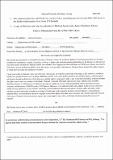| dc.contributor.advisor | Harte, Dr. Annette | |
| dc.contributor.author | Connaire, Adrian | |
| dc.date.accessioned | 2014-11-25T14:04:37Z | |
| dc.date.issued | 2014-10-17 | |
| dc.identifier.uri | http://hdl.handle.net/10379/4776 | |
| dc.description.abstract | This thesis describes a method which represents a novel approach for the prediction of coupled axial, bending and torque response of compliant beam structures undergoing finite deflections and rotations. The analysis of beams of this type has extensive application in the subsea industry particularly for the prediction of the extreme response of riser and mooring system components.
The approach presented in this work is based on the convected coordinates method, Euler-Bernoulli beam theory, the principle of virtual work and the FEM. It involves the development of two quasi-rotation measures including a quasi-material rotation definition to describe rotational deformation relative to a convected axis of a beam and a quasi-space rotation definition address the path dependent nature of rotations in three dimensions.
The particularly novel aspect of the work involves the use of a rate-of-rotation measure with respect to the axis of a beam and the means by which this quantity is used to establish linear transformations that describe quasi-material rotations in terms of quasi-space rotations. The transformations developed are shown to be particularly suitable for the development of the tangent stiffness matrix for use in conjunction with the Newton-Raphson method.
Numerical analysis and comparisons with other evaluation methods show that the formulation developed leads to significantly improved robustness and convergence rates compared to existing state-of-the-art methods for beam structures subject to highly nonlinear three-dimensional complex load paths. The examples also demonstrate the accuracy and efficiency of the method particularly for models with larger and less finite elements compared to alternative solutions. | en_US |
| dc.rights | Attribution-NonCommercial-NoDerivs 3.0 Ireland | |
| dc.rights.uri | https://creativecommons.org/licenses/by-nc-nd/3.0/ie/ | |
| dc.subject | Quasi-Rotation | en_US |
| dc.subject | Newton-Raphson | en_US |
| dc.subject | Subsea riser | en_US |
| dc.subject | Finite rotations | en_US |
| dc.subject | Finite element method | en_US |
| dc.title | A Quasi-Rotation Newton-Raphson method for the analysis of marine risser structures | en_US |
| dc.type | Thesis | en_US |
| dc.contributor.funder | MCS Kenny | en_US |
| dc.local.note | This thesis presents a method for analysing pipes that transport oil and gas between a seabed and a floating offshore platform. The method is shown to be particularly powerful in simulating situations where slender structures undergo complex deformations under the action of extreme loads, typical of those seen offshore. | en_US |
| dc.description.embargo | 2024-10-14 | |
| dc.local.final | Yes | en_US |
| nui.item.downloads | 4 | |


